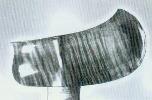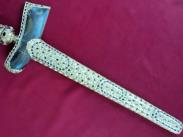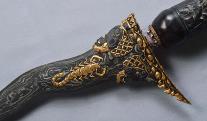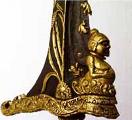|
|
|
K |
|
Kacang, Empu Ki is a known Empu from Madura. He began at the era of kingdom of Majapahit. His trademarks are wide and longer than usual Keris. The used iron is provided with hard and fine pores. The Gandik is obliquely. If a Kembang Kacang is present, it is relatively large. |
|
Kagok is a model of a warangka or a handle of Java that do not originate from Surakarta or Yogyakarta. There are some keris experts who claim a warangka Kagok and warangka Bancean or Bancihan are identical, but there are differences. |

|
Kagok, Gayaman very similar in shape to the Gayaman Bancihan or Bancean. The difference is that Gayaman Kagok has no Lata. These are often called warangka Gayaman Kagok Wayang or Gayaman Bincihan Wayang. |
|
Kagok Pakubuwanan, Ukiran is a grip shape (Ukiran) in Pakualaman style, Yogyakarta. It is like Pakualaman, but the "head" is more inclined forward. These handles are less popular, perhaps because they actually fit only to very large krisses. |
|
Kagok Rawa, Ukiran is a grip shape (Ukiran) in Pakualaman style, Yogyakarta. It is like Pakualaman, but the "head" is greater and it is overall flatter. |
|
Kakandikan or Kekandikan is a model of a warangka from Bali. It has a particular form and cannot be compared with the Warangkas in Java. The other warangka models of Bali are Godoan and Kojongan. |

|
Kala Cakra is a pamor consisting of dashes and appears like the letter X. The center forms a circle that looks like the center of pamor Sumur Bandung. The lines go to the edge of the blade. One finds this pamor exclusively to the Sor-Soran on krisses or Tombak. The magical power is that it provides benefits in warding off evil spirits. It belongs to pamor Rekan and is not suitable for everyone. |

|
Kala Cakra, Kinatah is an addition to the blade of a keris or Tombak goldplated. |

|
Kala Dete is a Dapur of a straight keris. It is also called kala Deteng or Kala Dite. It has a Kembang Kacang, a Lambe Gajah and Greneng. The blade has a normal length. It belongs to the rare Dapurs. |

|
Kala Lunga is a Dapur a keris with 23 Luk making it one of the unusual krisses (Kalawijan). The blade is slightly longer than normal. Their characteristic properties are Kembang Kacang, two Lambe Gajah, Jalen and Jalu Memet, double Sogokan, Sraweyan and full Greneng. It is a rare dapur and occurs only in antique krisses. |
|
Kala Misani is a Dapur of a straight keris. It has a Kembang Kacang, two Lambe Gajah, Tikel Alis, Gusen, Krawingan, Greneng and normally an Ada-Ada . This Dapur you meet more often. |

|
Warangka Gayaman Kagok Bancean Mediunan |
|
Kala Munyeng is a Dapur of a straight keris. The blade has a normal length and a simple Gandik, Tikel Alis and behind a Tingil. The front is a Sogokan which is very long and goes almost to the tip of the blade. There are no other Ricikan. |

|
Kala Nadah is a Dapur of a keris with 5 Luk. The blade length is normal and simple. This Keris has Pejetan and Srawejan. The Sogokan front is large and goes almost to the blade tip, the back there are no Sogokan. There is still a Greneng or Ri Pandan but more Ricikan are absent. This is a rare Dapur. |
|
Kala Tinantang is a dapur of a keris with 21 Luk. It is one of the Kalawijan Keris. It is slightly longer than a keris that is not a Kalawijan one. This Dapur has a Kembang Kacang, only one Lambe Gajah, a double Sogokan in normal size, Sraweyan and full Greneng. It is a rare Dapur. |
|
Kalawelang is a keris with a Dapur with 13 Luk. It has a special Kembang Kacang, a Lambe Gajah with Ri Pandan, but no other Ricikan, It is a rare Dapur |

|
Kalawijan or Kalawija or Palawija is the name for Keris with more than 13 Luk. There are also antique krisses with this number of luk that are of good quality and you can often find 19 Luk. Krisses with 15 and 17 Luk have the normal length of the blade, krisses with 19 Luk and more are slightly longer.
Some keris experts also call new creation and Dapur as Kalawijan e.g. the Dapur Sardula Mangsah that was done only at the Paku Buwana X. era in Surakarta. The term is also available for Tombak. There it is not directed to the number of luk but according to the form, an unusual shape called Kalawijan. |







|
Cengkrong 7 Luk
Tombak
Pedang Sabet |
|
Kalola is a Dapur a straight keris and one of the rare Dapurs. Some call this Dapur also Jaka Lola. The keris has a simple Gandik in normal size, only one Sogokan in normal size, Greneng and Ada-Ada. |

|
Kamorangan, Kinatah completely kinatah Lung Kamarogan is an ornament of a keris blade with kinatah having a pattern, that stylized plant. |
|
Kancingan or Lancingan is a Dapur of a keris with 17 Luk. thus one of the Kalawijan krisses. The blade length is normal and the Ricikan are simple. There is a Kembang Kacang, only one Lambe Gajah. It is a rare and usually Dapur occurs only in ancient krisses. |

|
Kanda Basuki is known as the Dapur of a straight keris and sufficient. The blade length is normal. Krisses have a Kembang Kacang, only one Lambe Gajah and a trace Jalu Memet, Sraweyan and full Greneng. |

|
Kalianjir, Empu is a known Empu who lived in Mataram at the time of the government Panembahan Senapati. |
|
Kantar is the Dapur of a keris with 13 Luk. The blade length is normal. It has a thin Ada-Ada, Kembang Kacang, only one Lambe Gajah and only one Sogokan and Sraweyan. |

|
Kanyut is part of a keris, which is located at the head of Ganja. There are upturned Kanyut that is called Kanyut Mlung-Ker and bent downward, and this is called Kanyut Lugas. |


|
Karacan is the Dapur of a Tombak with 7 Luk. The blade is quite thick compared to other blades. It has a thick Ada-Ada. The Tombak has a Bungkul, which is small and thin but. The blade is thicker at the end and toward the tip thinner. It is a rare Dapur. |

|
There is now also a Dapur of a Keris Java with 13 Luk. |






